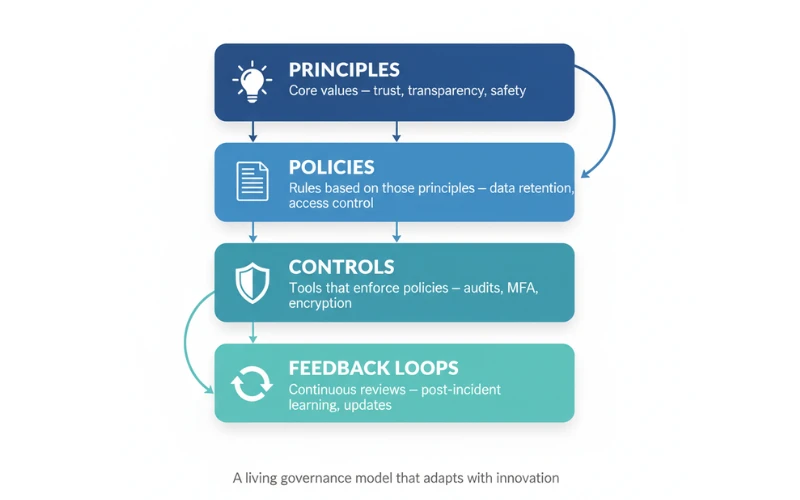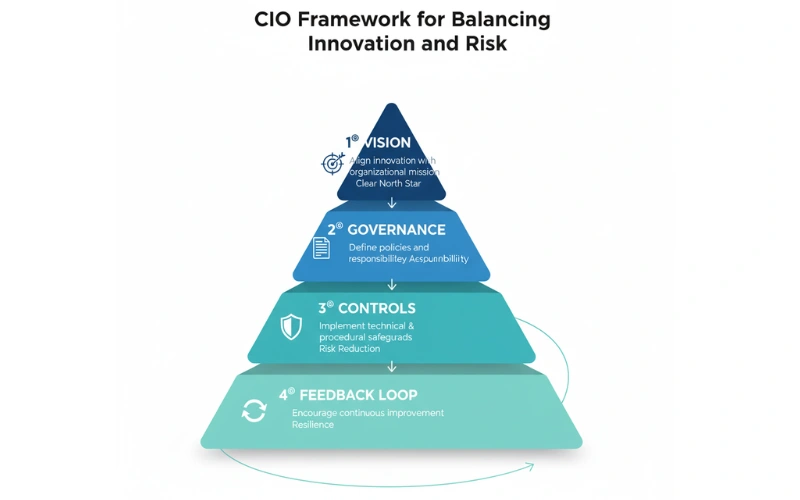If you’re a CIO in 2025, you probably feel the same pressure I do — to move faster, adopt new technologies, and still keep every system secure and compliant.
In high-stakes industries like healthcare and finance, that tension is constant. One side pushes for innovation — AI tools, automation, new digital experiences. The other side demands absolute reliability — zero downtime, zero data leaks, zero errors. Balancing both feels like walking a tightrope in a storm.
Over the years, I’ve learned that the secret isn’t to slow down innovation — it’s to build smarter governance frameworks that guide it safely. A good framework doesn’t block new ideas; it makes them sustainable.
In this article, I’ll share how CIOs like us can design governance systems that encourage innovation without exposing patients, customers, or businesses to unacceptable risk — and how often to update them as technology keeps changing.
Why Balancing Innovation and Risk Is So Hard
For most CIOs, the real challenge isn’t using new technology — it’s keeping innovation alive while following strict rules.
In healthcare and finance, every new tool or system must pass long approval steps to meet data privacy, safety, and security standards. These rules are important, but they also slow down progress.
Recent CIO research shows that about 74% of technology leaders believe regulatory pressure slows innovation. Everyone wants to build smarter systems — but nobody wants to break compliance laws in the process.
And the risk is real. The IBM Cost of a Data Breach Report 2024 found that a single healthcare data breach now costs around $11 million — the highest of any industry. With such high stakes, it’s easy to see why companies move carefully.
The problem isn’t just the rules. Inside companies, different teams often pull in different directions — IT wants to move fast, legal wants to stay safe, and operations just want everything to work smoothly.
Over time, I’ve learned one important truth:
Innovation without guardrails is chaos — but governance without innovation is decay.
The goal isn’t to remove risk completely. It’s to manage it wisely — to build a system where innovation and safety can grow together.
Step 1: Start with a Risk Map, Not a Product Roadmap
Before jumping into new projects or tools, I always begin with a risk map, not a product roadmap.
Most CIOs start by asking, “What can we build next?”
I ask, “What can we afford to break?”
Every innovation idea needs a risk lens — what’s mission-critical, what’s regulated, and what’s safe to test. I call it the 3-tier risk model:
| Tier | Type | Example |
|---|---|---|
| 1. Mission-Critical | Systems that can’t fail | Hospital patient data, payment gateways |
| 2. Regulated | High compliance needs | Customer records, KYC data |
| 3. Innovation Sandbox | Low risk to experiment | Internal automation tools, prototypes |

In healthcare, patient safety always comes before innovation speed. In finance, transaction accuracy matters more than a fancy new interface.
Two frameworks I often recommend as a baseline are the NIST Cybersecurity Framework (CSF) and ISO 27001. They help map out which areas of your organization need the most control — and where you can allow flexibility.
Step 2: Build a Living Governance Framework
The biggest mistake I see is treating governance like a fixed rulebook. In 2025, it has to be living — not static.
A good governance framework should be modular, automated, and regularly updated. I call it Governance-as-Code — because policies should be built right into your workflows, not buried in a PDF. A good governance framework should be modular, automated, and regularly updated — an approach known as Governance-as-Code.
For example, in a fintech CI/CD pipeline, you can embed automated checks for data compliance or access permissions before any code is deployed. This helps innovation move fast — but safely.
I recommend reviewing governance frameworks at least once every quarter or after any major technology change. It’s like updating an app — new risks appear, so your controls must evolve.
As I like to remind my own team:
“A governance model should evolve faster than your tech stack.”
And to visualize how this living framework works, imagine this 4-layer model:

This model keeps governance alive — it learns, adapts, and keeps pace with innovation.
Step 3: What a Smart Governance Framework Must Include
Once your framework is active, make sure it covers the essentials. These are the boxes I check every time I review one:
- ✅ Clear accountability — CIOs lead, but CISOs and business owners share responsibility.
- ✅ Data classification & access policies — define what’s confidential vs. public.
- ✅ Continuous compliance monitoring — automated alerts for violations.
- ✅ Incident response plan — clear escalation path and post-incident review.
- ✅ Change management workflow — every update should have rollback capability.
- ✅ Risk scoring system — assess each innovation project before launch.
- ✅ Integration with DevSecOps tools — merge development and security early.

Companies that follow this structured approach tend to innovate faster.
In fact, McKinsey’s 2024 Tech Governance Report found that organizations using continuous compliance tools innovate 30% faster on average.
Even large financial firms, like J.P. Morgan, now use AI-powered risk dashboards to monitor compliance in real time — turning governance from a manual chore into a digital advantage.
Step 4: Frequency of Review — When to Update Governance Models
Governance isn’t something you build once and forget.
How often you update it depends on how fast your industry changes.
In healthcare, I recommend reviewing frameworks every 6 months — or immediately after any security or safety incident.
In fintech, I prefer quarterly reviews, because new regulations and compliance checks appear constantly.
Most organizations I’ve worked with also run “governance fire drills” — simulated risk scenarios where teams test how their systems and response plans hold up under pressure. It’s the best way to find weak spots before a real incident exposes them.
According to PwC’s 2026 Global Digital Trust Insights report, more than 52% of CIOs said they’ve increased their policy update frequency since 2023 — a sign that modern IT leaders now treat governance as a living framework, not a static policy.
“Governance isn’t a binder on a shelf — it’s a system that learns every quarter.”
Step 5: The Biggest Mistake CIOs Make
The biggest mistake I’ve seen CIOs make is treating governance like bureaucracy instead of enablement.
When governance becomes a bottleneck, teams start avoiding it.
Developers see it as “extra paperwork”, not protection.
Adding too many approval layers might feel safe — but it actually slows down innovation.
The goal of governance is to build guardrails, not gates.
I tell my teams all the time:
“If your developers see governance as red tape, it’s already failing.”
The best CIOs design governance to empower teams — clear processes, simple checklists, and automatic compliance built into workflows.
Step 6: The Culture of Trust — Embedding Governance in People
Great governance starts with mindset, not manuals.
A policy is only as strong as the people who believe in it.
In my teams, I make sure governance isn’t just discussed during audits — it’s part of everyday conversations.
We review frameworks with the teams, not for them. That creates ownership and accountability.

Equally important is psychological safety — the ability for employees to report errors or risks without fear of punishment.
Google’s Project Aristotle found that psychological safety is the top factor in making teams effective. When people feel safe, they report early warnings — and that’s how governance truly works.
“Governance succeeds when people speak up, not when they stay silent.”
Step 7: A CIO’s Practical Framework for Balancing Innovation and Risk
To make governance simple and practical, I use a four-layer model — easy to visualize and easy to explain to teams.

This structure works for both startups and regulated enterprises.
Some visualize it as a pyramid (foundation-to-apex), while others see it as a loop — because modern governance never stops adapting.
“A smart CIO doesn’t just control change — they choreograph it.”
Smarter Governance Is About Empowerment, Not Control
At its core, good governance is about balance.
It protects innovation — it doesn’t block it.
The strongest governance frameworks I’ve seen don’t rely on fear; they rely on clarity and trust.
They give teams permission to experiment — responsibly.
In my own experience, the best systems weren’t the ones with the thickest policies; they were the ones that evolved, listened, and improved.
So if you’re a CIO or tech leader reading this:
Review your frameworks. Adapt them. And treat governance as your partner in innovation — not its rival.
Disclaimer
The insights and opinions shared in this article are based on professional experience and publicly available research. They are intended for informational and educational purposes only and should not be taken as legal, regulatory, or compliance advice. Readers are encouraged to consult relevant experts or official frameworks (such as NIST or ISO) before implementing governance or risk management strategies.
Contents
- 1 Why Balancing Innovation and Risk Is So Hard
- 2 Step 1: Start with a Risk Map, Not a Product Roadmap
- 3 Step 2: Build a Living Governance Framework
- 4 Step 3: What a Smart Governance Framework Must Include
- 5 Step 4: Frequency of Review — When to Update Governance Models
- 6 Step 5: The Biggest Mistake CIOs Make
- 7 Step 6: The Culture of Trust — Embedding Governance in People
- 8 Step 7: A CIO’s Practical Framework for Balancing Innovation and Risk
- 9 Smarter Governance Is About Empowerment, Not Control
- 10 Disclaimer



